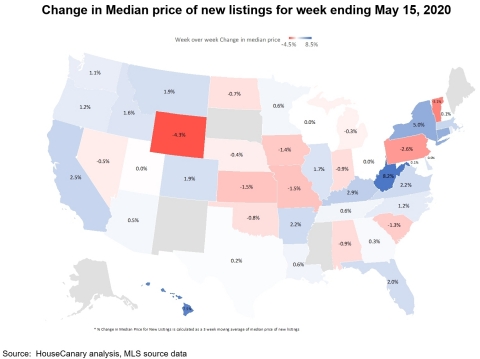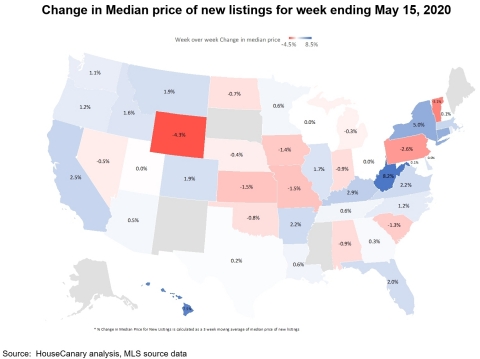SAN FRANCISCO--(BUSINESS WIRE)--Home valuation fintech pioneer HouseCanary today announced the continued review of states with sufficient property listing and transaction volume in the HouseCanary platform for 45 states and the District of Columbia. This issue of Market Pulse compares data between the week ending May 15, 2020, and the week ending March 13, 2020, detailing 22 listing-derived metrics.
Nationwide new listing volume was down 24.4% nationwide compared to the week ending March 13, when most COVID-19 measures were implemented. Although weekly new listing volume is up 19% from its lowest level, which occurred during the week ending April 17, nationwide weekly new listing volume has been increasing each week since that time. Nationwide weekly new listing volume has been increasing each week since that time. Since the beginning of COVID-19, the week ending March 13, through the week ending May 15, there have been 448,974 Net New Listings placed on the market.
For the week ending May 15, weekly volume of listings going into contract for single-family detached homes was up 2.4% nationwide compared to the week ending March 13, when most COVID-19 measures were implemented. Since the week ending March 13, 543,105 properties have gone into contract across 46 states. This represents the first week in which weekly contract volume was at or above volume compared to the week ending March 13. For the week ending May 15 there were 65,903 listings that went under contract. Weekly volume of listings going into contract is up 57.2% from its lowest level during the week ending April 10. Nationwide weekly contract volume has increased each week since April 10.
Weekly volume of single-family detached listings being removed from the market was down 12.8% nationwide compared to the week ending March 13. This represents the lowest weekly volume of listings being removed from the market since COVID-19 measures were implemented. For the week ending March 13 through May 15 there are 94,131 fewer properties in total supply than prior to COVID-19 driven by an inventory deficiency in 37 of 46 states. HouseCanary notes that since the week of April 5 homes being removed from the market have settled back down to pre-COVID-19 levels.
All of this activity has resulted in a tight supply of inventory available on the market. The total nationwide available inventory of single-family detached homes was down by 2.7% compared to the week ending March 13 and has remained relatively constant over the past eight weeks. Tight supply has helped stabilize prices in many markets through the weeks following March 13 when the first stay-at-home orders were implemented across the country.
Prior to the COVID-19 pandemic, housing price of new listings continued to rise in the majority of states. Using a 3-week moving average, 30 out of the 46 states reviewed continued to show a rise in median price of new listings relative to the prior week.
For the week ending May 15, the majority of states saw an increase in week-over-week median price on newly listed properties and only 16 states showed price declines. This is a continuation of the trend seen last week across most markets, where 32 out of 46 states had positive changes. Hawaii, New York, and Connecticut were among the states with the greatest median price increase for new listings for the second week in a row, while the largest declines were seen in Wyoming, Vermont, and Pennsylvania. The state showing the largest difference in percent change from the week ending May 8 was West Virginia. Despite having the largest price decline last week (-4.1%), West Virginia experienced the largest positive percent change (+8.2%) over the most recent week stemming from 169 new listings, which is in line with the median number of weekly listings since the beginning of COVID-19 to the current week.
“For the past eight weeks, since the COVID-19 stay-home and shelter-in-place measures were implemented, HouseCanary has been carefully monitoring changes in home sales and listing activity across the country,” said Jeremy Sicklick, Co-Founder and CEO of HouseCanary. “Although we are seeing weekly sales contract volume rising, properties are also beginning to sit on the market for longer periods in an overwhelming majority of the states, which could provide a glimpse into the future.”
As a nationwide real estate broker, HouseCanary’s broad multiple listing service (MLS) participation allows us to evaluate listing data and aggregate the number of new listings as well as the number of new listings going into contract for all single-family detached homes observed in the HouseCanary database. Using this data, HouseCanary continues to track listing volume, new listings, and median list price for 46 states and 48 individual MSAs.
HouseCanary will continue to monitor these and other economic indicators for the U.S. housing market and local markets on a weekly basis and report results to the news media. HouseCanary is committed to sharing trusted, real-time information given how quickly the housing markets are evolving. For more information about the data that HouseCanary is following, please visit www.housecanary.com.
About HouseCanary:
Founded in 2013, valuation-focused real estate brokerage HouseCanary provides software and services to reshape the real estate marketplace. Financial institutions, investors, lenders, mortgage investors, and consumers turn to HouseCanary for industry-leading valuations, forecasts, and transaction-support tools. These clients trust HouseCanary to fuel acquisition, underwriting, portfolio management, and more. Learn more at www.housecanary.com.




